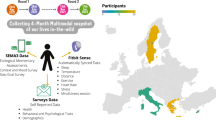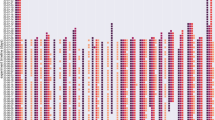Abstract
Inferring social relationships among individuals is a difficult problem, typically requiring either intrusive measurements (e.g., surveys) or convenience samples (e.g., ties captured by online social networking systems). Automatically collected activity data from mobile devices or similar sources provide a promising alternative for inexpensive and unobtrusive detection of interpersonal relationships. Here, we introduce a new method—activity correlation spectroscopy—for inferring relationships by exploiting the spectral and distributional structure of activity correlation within dyads. Unlike existing techniques, our approach can be employed with minimal, individual-level (i.e., non-relational), and non-identifying data that are easily collected using commodity hardware. We demonstrate our methodology via an application to detection of friendship and group co-membership using mobile device and survey data from the MIT Reality Mining study (Eagle et al. in Proc Natl Acad Sci 106:15274–15278, 2009).









Similar content being viewed by others
Notes
When not simultaneously active (e.g., for periods in which i and j are not both present within the system of interest), we take \({\hat{\rho }}_{ij}=0\).
References
Baker WE, Faulkner RR (1993) The social organization of conspiracy: illegal networks in the heavy equipment industry. Am Sociol Rev 58:837–860
Bernard HR, Killworth P, Kronenfeld D, Sailer L (1984) The problem of informant accuracy. Annu Rev Anthropol 13:495–517
Butts CT, Petrescu-Prahova M, Remy Cross B (2007) Responder communication networks in the World Trade Center disaster: implications for modeling of communication within emergency settings. J Math Sociol 31(2):121–147
Butts CT (2003) Network inference, error, and informant (in)accuracy: a Bayesian approach. Soc Netw 25:103–140
Choudhury MD, Mason W, Hofman J, Watts D (2010) Inferring relevant social networks from interpersonal communication. In: WWW’10 Proceedings of the 19th international conference on World Wide Web. pp 301–310
Clauset A, Moore C, Newman MEJ (2008) Hierarchical structure and the prediction of missing links in networks. Nature 453:98–101
Cornwell B, Schumm LP, Laumann EO, Kim J, Kim Y-J (2014) Assessment of social network change in a national longitudinal survey. J Gerontol Ser B Psychol Sci Soc Sci 69:S75–S82
Crandall DJ, Backstrom L, Cosley D, Suri S, Huttenlocher D, Kleinberg J (2010) Inferring social ties from geographic coincidences. Proc Natl Acad Sci 107:22436
Eagle N, Pentland A, Lazer D (2009) Inferring social network structure using mobile phone data. Proc Natl Acad Sci 106:15274–15278
Frank O, Strauss D (1986) Markov graphs. J Am Stat Assoc 81:832–842
Gjoka M, Sirivianos M, Markopoulou A, Yang X (2008) Poking Facebook: characterization of osn applications. In: WOSN’08: Proceedings of the first workshop on online social networks. Seattle, WA, USA, pp 31–36
Guimera R, Amaral LAN (2005) Functional cartography of complex metabolic networks. Nature 433:895–900
Kilduff M, Krackhardt D (2008) Interpersonal networks in organizations: cognition, dynamics, and culture. Cambridge University Press, Personality. ISBN 978-0-521-68558-0
Krackhardt D (1987) Cognitive social structures. Soc Netw 9(2):109–134
Lagomarsino MC, Jona P, Bassetti B, Isambert H (2001) Hierarchy and feedback in the evolution of the Escherichia coli transcription network. Proc Natl Acad Sci 104:5516–5520
Lomb NR (1976) Least-squares frequency analysis of unequally spaced data. Astrophys Space Sci 39:447–462
Marsden PV (2005) Recent developments in network measurement, chapter 2. In: Carrington PJ, Scott J, Wasserman S (eds) Models and methods in social network analysis. Cambridge University Press, Cambridge, pp 8–30
Martin A (2012) Don’t mention it: why people don’t share job information, when they do, and why it matters. Soc Netw 34:181–192
McDonald S, Day JC (2010) Race, gender and the invisible hand of social capital. Sociol Compass 4:532–543
McNett M, Voelker G (2005) Access and mobility of wireless PDA users. ACM SIGMOBILE Mob Comput Commun Rev 9:40–50
Miritello G, Moro E, Lara R, Martinez-Lopez R, Belchamber J, Roberts SGB, Dunbar RIM (2013) Time as a limited resource. Soc Netw 35:89–95
Morris M, Handcock MS, Hunter DR (2008) Specification of exponential family random graph models: terms and computational aspects. J Stat Softw 24:1548
Muehlenbrock M, Brdiczka O, Snowdon D, Meunier J (2004) Learning to detect user activity and availability from a variety of sensor data. In: PerCom’04: Proceedings of the 2004 IEEE international conference on pervasive computing, Piscataway, NY, USA
Newman M, Girvan M (2004) Finding and evaluating community structures in networks. Phys Rev E 69:026113
O’Malley AJ, Arbesman S, Steiger DM, Fowler JH, Christakis NA (2012) Egocentric social network structure, health, and pro-social behaviors in a national panel study of Americans. PLoS ONE 7:e36250
Paruchuri S (2009) Intra organizational networks, inter organizational networks, and the impact of central inventors: a longitudinal study of pharmaceutical firms. Organ Sci 21:1–18
Scargle JD (1982) Studies in astronomical time series analysis. II-statistical aspects of spectral analysis of unevenly spaced data. Astrophys J 263:835–853
Sharma N, Ghosh S, Benevenuto F, Ganguly N, Gummadi K (2012) Inferring who-is-who in the Twitter social network. In: Proceedings of the Workshop on Online Social Networks (with ACM SIGCOMM)
Smith S (2010) A test of sincerity: how Black and Latino service workers make decisions about making referrals. Ann Am Acad Polit Soc Sci 629:30–52
Sorenson O (2003) Social networks and industrial geography. J Evolut Econ 13:513–527
Tang J, Lou T, Kleinberg J (2012) Inferring social ties across heterogenous networks. In: WSDM, pp 743–752
Tang W, Zhuang H, Tang J (2011) Learning to infer social ties in large networks. In: Proceedings of ECML/PKDD-11
Wang C, Butts CT, Hipp JR, Jose R, Lakon CM (2016) Multiple imputation for missing edge data: a predictive evaluation method with application to Add Health. Soc Netw 45:89–98
Wasserman S, Faust K (1986) Social network analysis. Cambridge University Press, Cambridge
Wu Y, Pitipornvivat N, Zhao J, Yang S, Huang G, Qu H (2016) egoslider: Visual analysis of egocentric network evolution. IEEE Trans Vis Computer Graph 22(1):260–269
Wyatt D, Choudhury T, Bilmes J, Kitts JA (2011) Inferring colocation and conversational networks using privacy-sensitive audio. ACM Trans Intell Syst Technol 2(1):1–4
Author information
Authors and Affiliations
Corresponding author
Rights and permissions
About this article
Cite this article
Zhang, X., Butts, C.T. Activity correlation spectroscopy: a novel method for inferring social relationships from activity data. Soc. Netw. Anal. Min. 7, 1 (2017). https://doi.org/10.1007/s13278-016-0419-9
Received:
Revised:
Accepted:
Published:
DOI: https://doi.org/10.1007/s13278-016-0419-9




